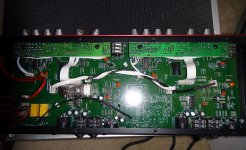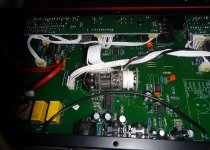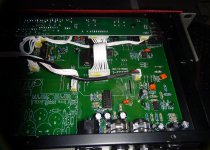Hello, I'm new to the community and beginning my journey/hobby of diy Audio. I bought an old SM Pro Audio TB202 and looking to replace the Op amps TL084. I have read many posts of possible replacements; TLE2074, LME49740, and AD713.
Can anyone give me some useful info or input on the above referenced Op amps ?
Thanks in advance,
Thom
Can anyone give me some useful info or input on the above referenced Op amps ?
Thanks in advance,
Thom
The TLE2074 has a significantly higher noise floor than the others. Given choice I'd choose one of the others. The National looks good.
Doc
Doc
The TLE2074 has a significantly higher noise floor than the others. Given choice I'd choose one of the others. The National looks good.
Doc
Thanks for the input Doc.. I read some posts indicating that the National was recommedned as well.... Not sure if I would need to change anything else if I were to use the LME49740?
Truth be told... I don't know a lick of german... other than what I learned from watching Hogan's Heros... My intro was a poor attempt at at humor/history though JFK... I'm a total newbie with an interest and a willingness to learn...
Not sure if I would need to change anything else if I were to use the LME49740?
From the data sheets the National part looks to be pin for pin compatible. Myself I'd probably swap one as a test case before proceeding.
If you are looking to quiet noise a good look at filter cap ESR might be worth it. Old electrolytics dry out and get higher internal resistance. Very typical source of noise increase. I'd have to take a peek at a schematic or at least maybe some digital pics of the innerds to realistically suggest more.
Doc
From the data sheets the National part looks to be pin for pin compatible. Myself I'd probably swap one as a test case before proceeding.
I'd have to take a peek at a schematic or at least maybe some digital pics of the innerds to realistically suggest more.
Doc
Thanks Doc.. I have been after the schematics for 2 weeks now... the company (SM Pro AUdio) seems to be hesitant to the up... Not sure why😕? But I will continue to peter them... hopefully this squeaky wheel will get the oil.. In the Meantime I will post some pics..
Thanks again
-Thom
From the data sheets the National part looks to be pin for pin compatible. Myself I'd probably swap one as a test case before proceeding.
I'd have to take a peek at a schematic or at least maybe some digital pics of the innerds to realistically suggest more.
Doc
Hi Doc... No schematic as of yet but I do have some pics of the inerds for you to take a peek...
The TLO84 is a JFET input device and the National chip is a bipolar input device, it's not really a drop-in replacement, so chances are the National chip won't preform as expected. The AD713, though somewhat dated, is a decent performer, so it would be a better chioce. The problem with "rolling chips" that are significantly faster into an existing circuit is the greater likelyhood there will be oscillation, usually in the MHz range. So unless you're prepared to redesign the existing circuitry to accommodate a different opamp type, stick with something similar to what's already there.
Mike
Mike
At least you are not a delicious jelly doughnut!
Hey, welcome aboard. DIY audio is a fun ride!
-Charlie
Hey, welcome aboard. DIY audio is a fun ride!
-Charlie
At least you are not a delicious jelly doughnut!
thanks for the welcome Charlie... I was thinking my reference was lost...
Looking at the pics you posted one of my first thoughts was "TI IC sockets! Yuk!" Notorious noise/ problem source. Should be replaced with Augut gold flashed IC sockets if you can find some.
As to the jelly donut... Whoever wants jelly donuts without any jelly; they're ready!
Doc
As to the jelly donut... Whoever wants jelly donuts without any jelly; they're ready!
Doc
Should be replaced with Augut gold flashed IC sockets if you can find some.
Doc
Hi Doc... How dificult would it be to replace for a novice

Hi Doc... How dificult would it be to replace for a novice
Ooh, tough question. Everybody takes to soldering differently. My suggestion is to first get some junk circuit boards and practice soldering on them. Get both a hand held solder sucker and some solder wick and practice removing and replacing parts on the junk board.
After that there is a trick I've guided novice techs towards in the past. A product called Chipqwik. Kind of pricey at $15-$20 a kit, but the kit contains a special flux and low temp solder that when you use it breaks the lead-tin bond between the pad and component lead and displaces it with the low melting temp solder. I've personally used it to successfully replace 128 pin flatpak IC's. One of the techs I guided to use it was quite frankly a lousy solderer who seemingly couldn't replace anything without damaging circuit traces.. After he started using chipqwik on everything he never lost another pad or trace.
Other than that the only tip I might suggest is use a sharp pointed hot tip that allows you to get in and out quick. A little touch of new solder will help your iron melt a joint quicker so you don't have to leave your tip on it so long.
Biggest tip is practice first before you work on something you treasure.
Doc
That chipqwik sounds pretty cool. I have found that many times just adding some new regular solder to the joint will aid in removing the old solder. One trick I use to help with desoldering without making a mess of the board is to cut up the old component while it is still on the board... you are going to throw it away anyway... if you wanted the thing, you wouldn't be removing it. DIP IC's can be cut on the top side, the IC removed, then you just get a needle nose pliers on one of the old leads on the component side, heat it up on the solder side and pull them out one at a time. Way easier, faster and cleaner than trying to desolder the thing keeping it in-tact. Especially if it is a multilayer board with plated through holes.. those can be a real pain to desolder all the pins clean at the same time.
Sockets may be a little trickier, since the leads are underneath the socket, but the cheap plastic sockets can be just snipped into peices with a diagonal cutter.
I also defiantly recommend practicing on some junk pc boards.
Sockets may be a little trickier, since the leads are underneath the socket, but the cheap plastic sockets can be just snipped into peices with a diagonal cutter.
I also defiantly recommend practicing on some junk pc boards.
- Status
- Not open for further replies.
- Home
- Member Areas
- Introductions
- Ich bin ein diy'er


